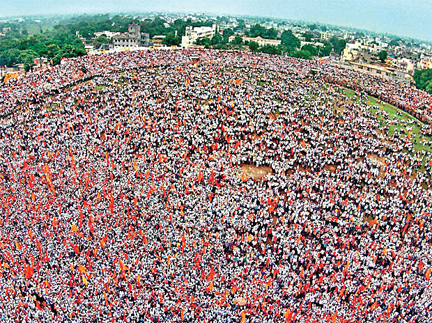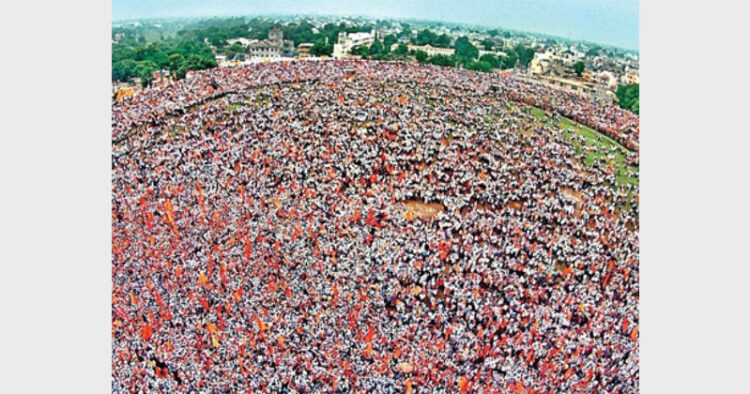Devidas Deshpande from Pune
 The streets are packed. Roads overflow with vehicles and people alike. With every passing day, another town or centre of district becomes the venues of the marches and the number of marchers is only growing. They walk silently, without uttering even a word but generating awe with their muted anger. Large tracts of land, spanning few kilometres at some places, can be seen filled with people with saffron and sometimes black flags in hand. The aerial photos showing people appearing as ants and filling up all the space go viral on the net. This is the typical scene that has become commonplace in every major city of the Maharashtra. The trend started with Aurangabad and spread on in other cities like Osmanabad, Latur, Nanded, Pune, Ahmednagar, Akola, Solapur and Satara. The marches, named the Maratha Kranti Morcha or the Maratha Revolution March, are being taken out by the Maratha community members.
The streets are packed. Roads overflow with vehicles and people alike. With every passing day, another town or centre of district becomes the venues of the marches and the number of marchers is only growing. They walk silently, without uttering even a word but generating awe with their muted anger. Large tracts of land, spanning few kilometres at some places, can be seen filled with people with saffron and sometimes black flags in hand. The aerial photos showing people appearing as ants and filling up all the space go viral on the net. This is the typical scene that has become commonplace in every major city of the Maharashtra. The trend started with Aurangabad and spread on in other cities like Osmanabad, Latur, Nanded, Pune, Ahmednagar, Akola, Solapur and Satara. The marches, named the Maratha Kranti Morcha or the Maratha Revolution March, are being taken out by the Maratha community members.
My government passed the law for Maratha reservation. But the matter is in court. We have collected 1,200 documents to substantiate the Marathas’ right to reservation —Devendra Fadnavis, Maharashtra Chief Minister
The immediate cause of the marches was a barbaric rape of a teenage girl in the Kopardi village in the Ahmednagar District. It took place in the mid-July. The victim belonged to the Maratha community while the perpetrators of the crime came from Dalit castes. The Marathas, a dominant if not ruling community in the political and social sphere of Maharashtra for at least a century, came on the street. The members claim to be pained by the suffering of the girl and demanded speedy justice for her. The demand, fair as it was, gained support from every quarter. However, soon the marchers came with other demands like providing reservation in jobs and education for them and scrapping, or at least amending, the Scheduled Caste/Scheduled Tribe Prevention of Atrocities Act, 1989 (Atrocity Act) that provides stringent punishment for the perpetrators of the crime against the weaker castes.
These demands, especially the reservation in jobs, resonated with the similar demand by the forward castes like Patels and Gujjars in other states. What made these marches unique is the absence of any overt social or political group in organising them and the extremely peaceful as well as the disciplined conduct of all the participants. Moreover, they are lead by the women and girls. The girls present the memorandums to the authorities and there are no speeches. No organisation is allowed to flash its name during the march. In some cities, the number of marchers was to the tune of 20 lakhs and yet there was not a single untoward incident. They even took care of cleaning the area after the march. This put them in contradiction with other protesters with similar demands elsewhere.
It perplexed the establishment and the onlookers. As no political personality was involved in mobilising them – nay, they were discouraged – the government did not know whom to address. Rather, there was confusion whether it was against the government at all, because none of the marchers said anything against the government. Moreover, they were unanimous that those who ruled the state for the last 60 years (barring four and half years in the 1990s), namely Congress and Nationalist Congress Party leadership, were to blame for their present predicament. For, the leaders from both these parties mainly came from the Maratha community. Therefore, it seemed as if they were protesting against their own leaders.
This is the reason why the former ruling parties were more insecure and upset with these marches than the BJP-led government. Chief Minister Devendra Fadnavis rightly pointed out that the earlier government made a mess of the reservation for Marathas by bringing in an ordinance that was termed invalid by the Supreme Court. He also showed readiness for the talks with the marchers and praised them for their unmatched patience. When Congress leaders like Radhakrishna Vikhe Patil and others tried to sneak in the march, they were heckled and made to walk in the last row. That showed the anger of the community members for those who have failed them.
As for the record, the government has handled the Kopardi case efficiently with the arrest of the perpetrators within 24 hours of the incident. Noted lawyer Ujjwal Nikam is appointed as the public prosecutor in the case. The family of the victim had expressed to this writer in July itself that the police, administration and the government acted swiftly and that they did not have any complaint with them. Besides, the marches started a full one month after the incident. Thus, for some, there is more to it than meets the eye.
“The outburst currently seen is a concoction of many things. It does not have any central issue. There is an issue of agrarian distress and the demand for implementing the recommendations of Swaminathan Commission. Who was at the helm during 2006, when this report was tabled. Why was no decision taken during this period? Another thing is that of reservation. This issue is currently in the court and how can the executive take a decision on a subject that is pending before the judiciary?” asks Hari Narke, the Mahatma Phule Chair Professor at the Savitribai Phule Pune University.
All concede the fact that even though Marathas were socially forward, they have remained backward in economic terms. That is why some Brahmin organisations and Dalit organisations also supported them. “The incident at the Kopardi was just a pretext. Like in other communities, a chasm has been created in the Maratha community during last few years. The common people have understood that they have no connection with the power even when the power rests in the hands of Marathas…The farmers who committed suicides because of the penurious conditions were from Maratha community. Higher, medical and vocational education has been out of reach of the poor Maratha youths because of high costs. They are facing problem of the unemployment as well. As a consequence, there is a discontent among the Marathas and they consider the reservation to Dalits as the reason for this,” wrote Dr Bhalchandra Mungekar, the former member of Planning Commission and prominent Dalit thinker recently.
True, Marathas have ruled the state since 1960. Of the 18 Chief Ministers in Maharashtra since its formation, 10 were Marathas. Even today, half of the legislators in the state come from this community. However, this power was concentrated in just 150 families. The Maratha community forms 33 percent of the 10 crore population of Maharashtra. Most of the community members are involved in agriculture, cooperatives or politics. For a last couple of decades, the state has been facing an agrarian crisis with thousands of farmers committing suicides. Additionally, the Congress-NCP
leadership usurped the cooperative sector and destroyed it with the corruption, nepotism and dynastic rule. The present government has initiated the cleaning process of the sector. It has upset those who have used it to their free run.
The demand of reconsidering Atrocity Act and reservation for jobs stems from this situation. NCP President and former Union Agriculture Minister Sharad Pawar first spoke of amending the Atrocity Act, but later took a U-turn. His nephew and former Deputy Chief Minister Ajit Pawar took a dig at the Marathas themselves by saying, “They are elitist at the time of their marriages and ask for the
reservation in jobs. This is hypocrisy.” Most of other
politicians have refrained from commenting on the marches. They are not sure whether they would benefit from them or suffer damage.
The repercussions of these marches are being felt. The show of strength by the largest community in Maharashtra would create a fear among lesser constituents. That is why Dalit and OBC communities have planned their marches in response to the marches. In More’s opinion, every social organisation has a right to put forward its stand and hence, these counter-marches are a natural phenomenon. However, CM Fadnavis has discouraged those marches and assured that the Maratha marches are not against any community or any faith. However, the churning has begun and only time will tell whether it can become a revolution. n





![A Representative image [ANI Photo]](https://organiser.org/wp-content/uploads/2025/12/representative-image-e1765612818961-120x70.webp)







Comments